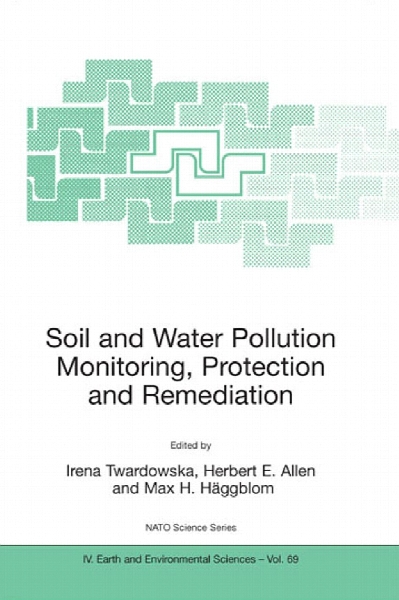Soil and water pollution monitoring, protection and remediation
- نوع فایل : کتاب
- زبان : انگلیسی
- مؤلف : I (ed ) Twardowska; H E (ed ) Allen; M M (ed ) Häggblom
- ناشر : Dordrecht : Springer
- چاپ و سال / کشور: 2006
- شابک / ISBN : 9781402047268
Description
Contents.-Preface.- Acknowledgements.- Contributors.- 1. Introduction: Spread and Distribution of Hazardous Chemicals in Soils and Water -- A Global Problem 1.1. Diagnosis and prognosis of the distribution of contaminants in the geosphere; U. Mingelgrin and A.Nasser.-1.2. Persistent organic pollutants in Egypt - an overview Moh.T.Ahmed.- 2. Fate and Behavior of Anthropogenic Pollutants in Soils and Water. 2.1. Fundamental Issues in Sorption Related to Physical and Biological Remediation of Soils; J. J. Pignatello.- 2.2. The role of humic substances in the fate of anthropogenic organic pollutants in soil with emphasis on endocrine disruptor compounds; E.Loffredo and N.Senesi.- 2.3. Incorporating bioavailability into criteria for metals; H.E. Allen and C.R. Janssen.- 2.4. The metal uptake and accumulation in fish living in polluted waters; B. Jezierska and M.Witeska.- 3. Advances in Chemical and Biological Techniques for Environmental Monitoring and Predicting. 3.1. Sensoristic approach to biological damage and risk assessment; L. Campanella and C.Costanza.-3.2. Advanced environmental biochemical sensor for water monitoring. Automated Water Analyser Computer Supported System (AWACSS); G.Proll et al.- 3.3. Genetically engineered microorganisms for pollution monitoring; S. Belkin.- 3.4. Some advances in environmental analytics and monitoring; A.Kot-Wasik and J.Namiesnik.-3.5. Fiber optic system for water spectroscopy; A. G. Mignani et al.-, 3.6. Predicting metal uptake by plants using DGT technique H. Zhang and W. Davison .- 3.7. On conceptual and numerical modeling of flow and transport in groundwater with the aid of tracers: a case study; J.Kania et al.- 4. Novel Physico-Chemical Techniques of Soil and Water Protection and Remediation. 4.1. Current and future in situ treatment techniques for the remediation of hazardous substances in soil, sediments, and groundwater; R.A. Olexsey and R..A.. Parker.- 4.2. Long-term performance of permeable reactive barriers: lessons learned on design, contaminant treatment, longevity, performance monitoring and cost -- an overview; R.W. Puls.- 4.3. Using abundant waste and natural materials for soil and groundwater protection against contamination with heavy metals. Prospects and areas of application; I.Twardowska et al.- 4.4. Mediating effects of humic substances in the contaminated environments. Concepts, results, and prospects; I. V. Perminova et al.- 4.5. Metal binding by humic substances and dissolved organic matter derived from compost; Y.Chen et al.- 4.6. The effect of organic matter from brown coal on bioavailability of heavy metals in contaminated soils; S.Piotr et al.- 4.7. Use of activated carbon for soil bioremediation; G. K. Vasilyeva et al.- 4.8 Adsorption of anions onto sol-gel generated double hydrous oxides; N.I. Chubar et al.- 4.9. Xenobiotic pharmaceuticals in water and methods to prevent their appearance in drinking water.Photolytic and Photocatalytic Degradation of Pharmaceuticals; F.H. Frimmel and T.E. Doll.- 4.10. UV/VIS light-enhanced photocatalysis for water treatment and protection; J. Hupka et al.- 4.11..New horizons in purification of liquids. Novel colloidal and interfacial strategies to remove hazardous molecules, viruses and other microorganisms from water; D.O. Shah and M.A. James.- 4.12. Fly ash-organic byproduct mixture as soil amendment K. S. Sajwan et al.- 5. Biosystems for Non-Destructive Remediation and Immobilization of Pollutants in Soils, Sediments and Detoxification of Industrial Wastes. 5.1. Phytoremediation and phytotechnologies: a review for the present and the future; N.Marmiroli et al.- 5.2. Constructed wetlands and their performance for treatment of water contaminated with arsenic and heavy metals; U. Stottmeister et al.- 5.3. Disposal of sewage effluent and biosolids in eucalyptus plantations: a lysimeter simulation study; P.Fine et al.- 5.4. Phytoremediation of explosives in toxic wastes; Th. Vanek et al.- 5.5. Floating aquatic macrophytes as a decontamination tool for antimicrobial drugs; C.Fomi et al.- 5.6. Plant tolerance to heavy metals, a risk for food toxicity or a means for food fortification with essential metals: the Allium Schoenoprasum model; A. Golan-Goldhirsh .- 6. Assembled Plant and Microbial Technologies for Bioremediation of Pollutants..6.1. Ecoremediation. . Cooperation between plants and soil microorganisms, molecular aspects and limits; M. Tissut et al.- 6.2. Anaerobic dehalogenation of halogenated organic compounds: novel strategies for bioremediation of contaminated sediments; M.M. Haggblom et al.-, 6.3. Molecular tools for microbial remediation - contaminants uptake, metabolism and biosensing; E. Z. Ron .- 6.4. Role of mycorrhizal fungi in phytoremediation and toxicity monitoring of heavy metal rich industrial wastes in Southern Poland; K.Turnau et al.- 6.5. Biodegradation of petroleum hydrocarbons by keratinolytic fungi; K.Ulfig et al.- 7. Management strategies for large-area contaminated sites. 7.1. Integrated management strategy for complex groundwater contamination at a megasite scale; G. Malina et al.- 7.2. Management options for regionally contaminated aquifers: a case study at Bitterfeld, Germany; H. Weiss et al.- Subject Index.
Details development in early warning monitoring of anthropogenic pollution of soil and water.


